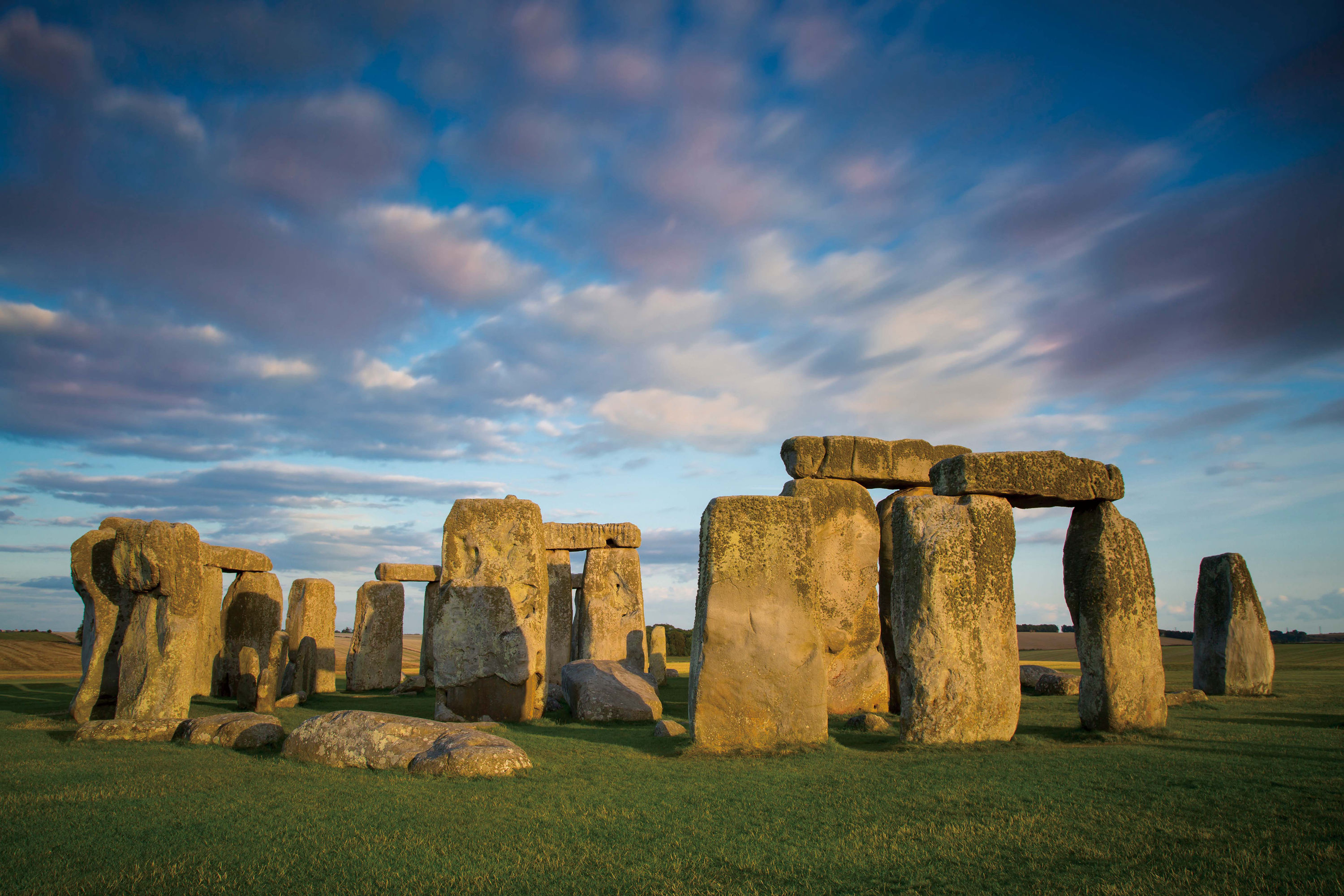




 Stonehenge in Wiltshire
Stonehenge in Wiltshire
A pile of rocks in the middle of England might not seem like a big deal, but it is if they're tall and standing straight up. In Wiltshire (威尔特郡), England there is a place known as Stonehenge (巨石阵) and it is one of the most famous rock structures in the world.
Most archaeologists think Stonehenge was built between 2000 and 3000 BC. It is made up of a ring of stones all standing up straight, with a few stones laid horizontally across the top. In the ring there is an outer ring and an inner ring. No one really knows how the stones were raised and placed into position.
Even less is known about where the stones came from. Stones as large as those found in Stonehenge are not common in the part of England where Stonehenge sits. Some archaeologists think that people dragged the stones across land and towed them through the water using boats. They think that many of the stones travelled up to 250 miles to get to the location of Stonehenge. Geologists, however, have a different, and more likely, idea. They think that glaciers left many of the boulders in the area. Then, the makers of Stonehenge just moved all the boulders to the spot where Stonehenge now stands.

What is even more puzzling is why Stonehenge was built. Some say the monument was used to help ancient humans predict solar eclipses and tell the difference between summer and winter. Included in the monument is a heel stone. The sun rises directly over this stone during the summer and winter solstice (至日). Others think Stonehenge was a sort of hospital because many skeletons with large wounds have been found nearby. Still others think it was a burial ground, as many skeletons dating around the same time have been found around the monument.
Regardless of how and why it was built, Stonehenge is still a pretty neat pile of rocks. Every year, nearly one million people head to Wiltshire, England to see it for themselves.
1. Where is Stonehenge?
A. In England.
B. In America.
C. In India.
D. In Australia.
2. What makes this famous rock structure unique?
A. It is very pretty.
B. The rocks stand straight up.
C. It is in the middle of England.
D. It has a distinctive colour.
3. Which explanation for the stones is most believable?
A. They were carried there from hundreds of miles away.
B. They were brought there by aliens.
C. They were left on the land by glaciers.
D. The article does not say.
4. What do the skeletons make archaeologists believe?
A. Visiting Stonehenge was very dangerous.
B. Carrying the rocks caused many deaths.
C. The heat from the sun caused people to die.
D. The site may have been ancient burial grounds.
5. Which of the following statements is true according to the passage?
A. Archaeologists and geologists have different views on the source of the stones.
B. It is said that the monument can help ancient people predict lunar eclipses.
C. We have already known how and why Stonehenge was built.
D. About one billion people go to visit Wiltshire every year.
答案:ABCDA
pile
n. 堆,摞,叠 vt. 摞起;堆积;把…堆积起来
搭 a pile of... 一摞… pile up 堆积,积累
straight
adv. 径直;直 adj. 直的;笔直的
英 not in a curve or at an angle; in a straight line
搭 go straight 直走;改邪归正
famous
adj. 著名的,出名的
英 known about by many people
structure
n. 建筑物;结构,构造
记 词根记忆:struct(建造)+ure(表结果)→建筑物
raise
vt. 养育;饲养;举起;增加,提高;筹募;提及
英 to lift or move sth to a higher level
记 联想记忆:即使把头抬高(raise)也看不到上涨(rise)的房价
例 Mike raised cattle when he was young. 迈克小的时候养过牛。
position
n. 位置;职位
记 词根记忆:posit(放)+ion(表名词)→放下的地方→位置
common
adj. 普通的,常见的;公共的;共有的
搭 common knowledge 常识
drag
vt. (费力地)拖,拉,扯;硬拽
例 Mom dragged us to a classical music concert. 妈妈硬拉我们去听了一场古典音乐会。
monument
n. 纪念碑,纪念馆;古迹
英 a building that has special historical importance
记 词根记忆:monu(提醒)+ment(表物)→提醒人们的标志物→纪念碑
predict
vt. 预言,预料,预测
记 词根记忆:pre(预先)+dict(说)→预言
例 Nobody can predict the outcome. 谁也无法预料结果。
heel
n. 脚后跟;鞋跟
记 联想记忆:脚后跟(heel)的伤痊愈(heal)了
wound
vt. 使受伤 n. 伤口,创伤
例 He got wounded in the war. 他在战争中受伤了。
archaeologist
n. 考古学家
horizontally
adv. 水平地
英 in a way that is flat and level; across and parallel to the ground rather than up and down
inner
adj. 内部的;内心的 n. 内部
英 inside; towards or close to the centre of a place
记 词根记忆:in(在…里面)+ner→内部的;内心的
tow
vt./n. 拖,牵引
英 to pull a car or boat behind another vehicle, using a rope or chain
搭 tow ...away 把…拖走
location
n. 位置,场所;(电影的)外景拍摄地
搭 geographical location 地理位置 the golden location 黄金地段
geologist
n. 地质学家
glacier
n. 冰川;冰河
英 a large mass of ice, formed by snow on mountains, that moves very slowly down a valley
记 词根记忆:glac(冰)+ier(表物)→冰川
boulder
n. 巨石,巨砾
英 a very large rock which has been shaped by water or the weather
记 联想记忆:肩(shoulder)上扛着巨石(boulder)
spot
vt. 发现;看出;注意到 n. 地点,场所;斑点;污迹
例 You’ll spot the cinema right next to the underground station. 你会在地铁站旁边看到这家电影院。
eclipse
vt. 遮住(…的)光;使相形见绌 n. 日食;月食
搭 solar eclipse 日食 lunar eclipse 月食
skeleton
n. 骨骼;骨架;梗概;框架
搭 internal skeleton 内部框架